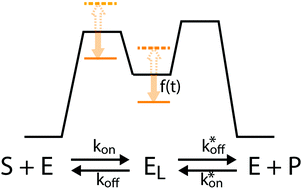当前位置:
X-MOL 学术
›
Chem. Soc. Rev.
›
论文详情
Our official English website, www.x-mol.net, welcomes your
feedback! (Note: you will need to create a separate account there.)
Mastering the non-equilibrium assembly and operation of molecular machines
Chemical Society Reviews ( IF 40.4 ) Pub Date : 2017-03-24 00:00:00 , DOI: 10.1039/c7cs00068e Cristian Pezzato 1, 2, 3, 4 , Chuyang Cheng 1, 2, 3, 4 , J. Fraser Stoddart 1, 2, 3, 4 , R. Dean Astumian 4, 5, 6, 7
Chemical Society Reviews ( IF 40.4 ) Pub Date : 2017-03-24 00:00:00 , DOI: 10.1039/c7cs00068e Cristian Pezzato 1, 2, 3, 4 , Chuyang Cheng 1, 2, 3, 4 , J. Fraser Stoddart 1, 2, 3, 4 , R. Dean Astumian 4, 5, 6, 7
Affiliation

|
In mechanically interlocked compounds, such as rotaxanes and catenanes, the molecules are held together by mechanical rather than chemical bonds. These compounds can be engineered to have several well-defined mechanical states by incorporating recognition sites between the different components. The rates of the transitions between the recognition sites can be controlled by introducing steric “speed bumps” or electrostatically switchable gates. A mechanism for the absorption of energy can also be included by adding photoactive, catalytically active, or redox-active recognition sites, or even charges and dipoles. At equilibrium, these Mechanically Interlocked Molecules (MIMs) undergo thermally activated transitions continuously between their different mechanical states where every transition is as likely as its microscopic reverse. External energy, for example, light, external modulation of the chemical and/or physical environment or catalysis of an exergonic reaction, drives the system away from equilibrium. The absorption of energy from these processes can be used to favour some, and suppress other, transitions so that completion of a mechanical cycle in a direction in which work is done on the environment – the requisite of a molecular machine – is more likely than completion in a direction in which work is absorbed from the environment. In this Tutorial Review, we discuss the different design principles by which molecular machines can be engineered to use different sources of energy to carry out self-organization and the performance of work in their environments.
中文翻译:

掌握分子机器的非平衡组装和操作
在机械互锁的化合物中,例如轮烷和链烷,分子通过机械而不是化学键保持在一起。通过在不同组件之间合并识别位点,可以将这些化合物设计为具有几种定义明确的机械状态。识别位点之间的过渡速率可以通过引入空间“减速带”或静电可切换门来控制。通过添加光活性,催化活性或氧化还原活性识别位点,甚至电荷和偶极子,也可以包括能量吸收的机制。在平衡状态下,这些机械连锁分子(MIM)在其不同的机械状态之间连续经历热激活的跃迁,其中每个跃迁都可能与其微观反转一样。外部能量 例如,光,化学和/或物理环境的外部调制或能动反应的催化使系统远离平衡。从这些过程中吸收能量可以用来促进某些过渡,而抑制其他过渡,因此,完成在环境中完成工作的方向上的机械循环(分子机器的必要条件)比完成更可能。朝着从环境吸收工作的方向发展。在本教程审查中,我们讨论了分子机器可以设计为使用不同能源在其环境中进行自组织和工作表现的不同设计原理。驱使系统脱离平衡。从这些过程中吸收能量可以用来促进某些过渡,而抑制其他过渡,因此,完成在环境中完成工作的方向上的机械循环(分子机器的必要条件)比完成更可能。朝着从环境吸收工作的方向发展。在本教程审查中,我们讨论了分子机器可以设计为使用不同能源在其环境中进行自组织和工作表现的不同设计原理。驱使系统脱离平衡。从这些过程中吸收能量可以用来促进某些过渡,而抑制其他过渡,因此,完成在环境中完成工作的方向上的机械循环(分子机器的必要条件)比完成更可能。朝着从环境吸收工作的方向发展。在本教程审查中,我们讨论了分子机器可以设计为使用不同能源在其环境中进行自组织和工作表现的不同设计原理。过渡,使得完成在环境中完成工作的方向上的机械循环(分子机器的必要条件)比完成从环境中吸收工作的方向上的完成更有可能。在本教程审查中,我们讨论了分子机器可以设计为使用不同能源在其环境中进行自组织和工作表现的不同设计原理。过渡,使得完成在环境中完成工作的方向上的机械循环(分子机器的必要条件)比完成从环境中吸收工作的方向上的完成更有可能。在本教程审查中,我们讨论了分子机器可以设计为使用不同能源在其环境中进行自组织和工作表现的不同设计原理。
更新日期:2017-09-18
中文翻译:

掌握分子机器的非平衡组装和操作
在机械互锁的化合物中,例如轮烷和链烷,分子通过机械而不是化学键保持在一起。通过在不同组件之间合并识别位点,可以将这些化合物设计为具有几种定义明确的机械状态。识别位点之间的过渡速率可以通过引入空间“减速带”或静电可切换门来控制。通过添加光活性,催化活性或氧化还原活性识别位点,甚至电荷和偶极子,也可以包括能量吸收的机制。在平衡状态下,这些机械连锁分子(MIM)在其不同的机械状态之间连续经历热激活的跃迁,其中每个跃迁都可能与其微观反转一样。外部能量 例如,光,化学和/或物理环境的外部调制或能动反应的催化使系统远离平衡。从这些过程中吸收能量可以用来促进某些过渡,而抑制其他过渡,因此,完成在环境中完成工作的方向上的机械循环(分子机器的必要条件)比完成更可能。朝着从环境吸收工作的方向发展。在本教程审查中,我们讨论了分子机器可以设计为使用不同能源在其环境中进行自组织和工作表现的不同设计原理。驱使系统脱离平衡。从这些过程中吸收能量可以用来促进某些过渡,而抑制其他过渡,因此,完成在环境中完成工作的方向上的机械循环(分子机器的必要条件)比完成更可能。朝着从环境吸收工作的方向发展。在本教程审查中,我们讨论了分子机器可以设计为使用不同能源在其环境中进行自组织和工作表现的不同设计原理。驱使系统脱离平衡。从这些过程中吸收能量可以用来促进某些过渡,而抑制其他过渡,因此,完成在环境中完成工作的方向上的机械循环(分子机器的必要条件)比完成更可能。朝着从环境吸收工作的方向发展。在本教程审查中,我们讨论了分子机器可以设计为使用不同能源在其环境中进行自组织和工作表现的不同设计原理。过渡,使得完成在环境中完成工作的方向上的机械循环(分子机器的必要条件)比完成从环境中吸收工作的方向上的完成更有可能。在本教程审查中,我们讨论了分子机器可以设计为使用不同能源在其环境中进行自组织和工作表现的不同设计原理。过渡,使得完成在环境中完成工作的方向上的机械循环(分子机器的必要条件)比完成从环境中吸收工作的方向上的完成更有可能。在本教程审查中,我们讨论了分子机器可以设计为使用不同能源在其环境中进行自组织和工作表现的不同设计原理。











































 京公网安备 11010802027423号
京公网安备 11010802027423号